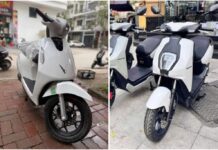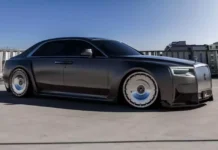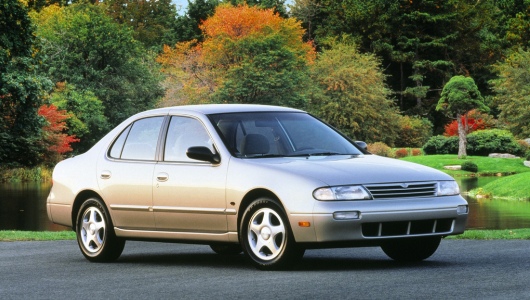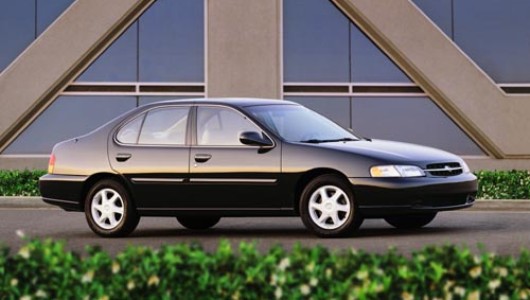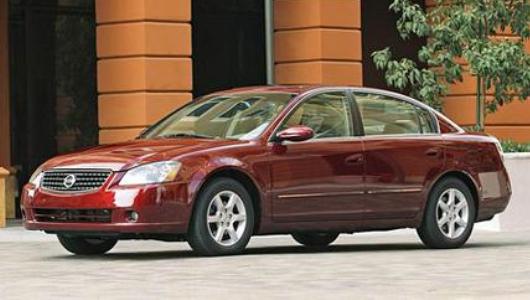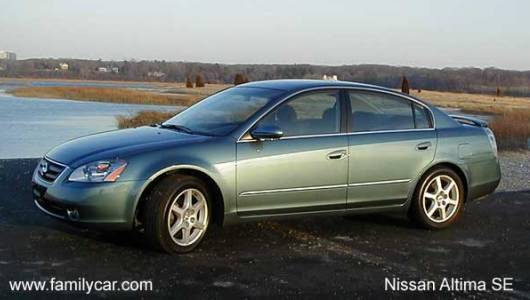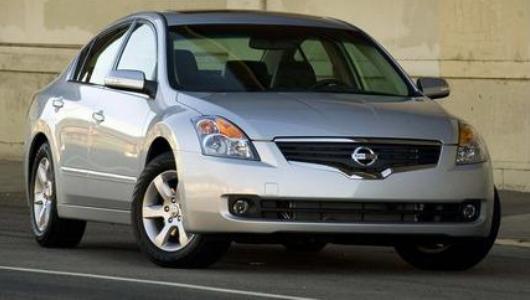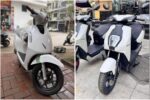Perhaps nowadays, Nissan Altima is the “most annoying” name in the mid-size sedan race. How has the journey that this car has been through changed?
The resounding success in all markets, Nissan Altima has made the automotive industry go through from one surprise to another. Over the past 20 years and 5 generations that have been launched up to this point, Altima is no longer just an “acceptable” mid-size sedan, it has risen to become a leading force in its segment and is aiming for dominance and is dreaming of becoming a king.
First generation: 1993-1997
The name “Altima” initially referred to a model of the Nissan Laurel mid-size car that was sold in Central America and the Caribbean prior to 1992. In 1993, Nissan discontinued the Stanza line and replaced it with the Altima, which was produced in the US. The first Altima rolled off the assembly line in Smyrna, Tenn in June 1992 as a 1993 model. All Altimas were produced in Smyrna until June 2004 when Nissan’s Canton plant in Mississippi began supplementing Altima production to meet high market demand.
Nissan Altima first generation
Initially, the official name of the car was “Stanza Altima.” You can see the small “Stanza” lettering to the left of the Altima emblem on the trunk lids of 1993 models. Although the name Stanza was placed there mostly to comply with regulations rather than Nissan’s lack of confidence in renaming the mid-size car in the long-running Sentra-Stanza-Maxima lineup, it still raised concerns at the time about the acceptance of the public. This concern was unfounded as the Altima had an almost immediate impact on the mid-size sedan segment, which was then dominated by the two compatriots Honda Accord and Toyota Camry.
All Altima models used Nissan’s 150 horsepower DOHC 4-cylinder engine combined with a 5-speed manual or 4-speed automatic transmission. The suspension system includes stabilizer bars and strut weighting at both ends and is recognized for providing sporty looks as well as responsive handling. Models include the base XE model, the mid-range GXE, the sporty SE, and the luxurious GLE.
The base XE model is rarely equipped with power windows. The GXE model features power windows, a power-retractable antenna, a digital clock on the dashboard, and color-coordinated plastic grilles. XE and GXE only have fixed intermittent wipers.
In addition to the above features, the SE features a sturdier suspension system, fog lights, a 3-legged rear flow dam, side shields, and sports seats (plus a standard sunroof in 1994-1995). It also features 4-wheel disc brakes, only appearing on other models when ABS is required.
The GLE improvements include a digital head-up display screen (only in 1993 and 1994) that can display speed in mph or km/h, turn signals. Other features include a coin slot designed into the fuse cover (1993 and 1994), adjustable upper belt support, automatic climate control, keyless entry with an alarm (optional), carpet, turn signals, sunroof, and a 6-speaker CD/Cassette sound system with a black grille. Both SE and GLE are equipped with alloy wheels and continuous wipers.
The 1993 Altima came with a pink-hued wood-grain dashboard and only a driver side airbag, automatic seat belts. The 1994 Altima had a dark wood-grain dashboard, a passenger side airbag, and standard seat belts. The 1995 model brought a new flashing strip grille, new taillights (red and clear) and a 2-legged rear bumper with red LED brake lights for SE. Nissan also added wheel covers for the base models in 1996. In 1997, the GXE introduced a “limited” option package including alloy wheels, keyless entry, alarm, carpet, and a limited-edition logo on each side near the front wheels. Most of the final-year Altima models were dubbed the “1997.5” models to announce the added necessary crash protection to meet 1997 side crash standards.
Second generation (1998-2001)
The second-generation Altima started production in 1998 and continued through the 2001 models. Once again this model was designed in California and produced in Tennessee, it brings more power (155 horsepower before 2000) and a more responsive driving feel. The car also offers a much more comfortable interior, higher quality, and more equipment options. For 2001, the first limited edition model was introduced and became an important part of the Altima’s pricing strategy for the following years.
The second-generation (L30 model frame) is dedicated to the US market, once again designed by Nissan’s California center. The new interior brings a new glove box and cup holder compartment, folding rear seats (except for the XE version), and airbags.
Nissan Altima second generation (1998 model)
The overall dimensions remain the same, bringing a better distribution of space and resulting in a more spacious cabin.
Versions include the base XE model, GXE, SE, and GLE. The SE sports model can be distinguished by a black grille, fog lights, a two-leg rear spoiler, alloy wheels, and a white-faced voltmeter. In this generation, all GLE models are equipped with standard leather seats.
Most changes for the 2000 model. The engine’s power was increased from 150 to 155 horsepower while the car’s improved acceleration from 0-100km/h from 8.7s to 8.4s. This Altima is slightly longer and has a deeper grille, one-piece headlights with turn signals, red taillights. The 2.5L 4-cylinder engine helps this sedan accelerate from 0-100km/h in just 8.6s, making it more competitive in the segment.
Third Generation: 2002-2006.
While the first two generations of the Altima laid the foundation and were very successful compared to its predecessor, the third generation truly put the Altima on the map of power in the automotive industry and the shopping list of customers.
It was the first mass-market vehicle built on Nissan’s new FF-L platform, uniquely for North America and without an equivalent model in Japan. The car was produced in the years from 2002 to 2006. This new design has 18-inch wheels and is the first generation of the Altima to offer a 3.5L V6 engine in addition to the 2.5L 4-cylinder engine. The size of this Altima has increased significantly, with the interior expanded to 3364L. The interior dimensions of the Altima have even surpassed the larger Maxima sedan, so in 2004, the Maxima had to revise its dimensions. The new Altima also improves handling and brings a more powerful look. The media and consumers have had positive reviews for this car as the Altima has helped Nissan revive its products in the early years of the new century.
Altima third generation
The idea behind the design and engineering of the third-generation Altima was simply to stop copying Accord and Camry as we were doing and create our own niche,” said Al Castignetti, Nissan’s vice president of sales and marketing. “We brought the 2002 Altima to market under the banner ‘A remedy for sedans,’ showing people that they could either blend in with the crowd or stand out with Altima’s Bold Style and Driver-Oriented Performance. With this car, Nissan found its own identity in the mid-size sedan segment and continues that identity to this day.
The 2002 Altima was honored to win the “North American Car of the Year” award, the first Asian-named car to win this coveted award determined by a panel of 50 independent auto journalists from the US and Canada. In 2002, it was also named “Car of the Year” by Motoweek on PBS. And for the first time, auto media saw that the Altima was not just a replacement for the top mid-size sedans, it balanced or surpassed the longtime best-sellers in the segment.
2002 model
2003-2004 models are equipped with a two-tone dashboard while the 3.5 SE receives a power increase, from 240 to 245 horsepower while maintaining the torque of 333 Nm. The 2.5l 4-cylinder engine helps this sedan accelerate from 0-100km/h in just 8.6s, making it more competitive in the segment.
Altima 2005-2006 receives updates from the front grille, red taillights, redesigned interior materials, and an optional DVD-based navigation system. The V6 engine delivers 250 horsepower and 338Nm of torque with a 0-100km/h acceleration time in just 5.9s, using the Xtronic 5-speed gearbox. Another new thing is the birth of the SE-R model with 260 horsepower and 340Nm of torque, a 6-speed manual transmission (optional automatic transmission), upgraded braking system, 18-inch wheels, a sports suspension system, and a large exhaust system. The Topspeed.com website measured SE-R’s acceleration time from 0-100km/h to be 5.7s.
Fourth generation: 2002-2006
The fourth-generation Nissan Altima was announced at the New York Auto Show on June 12, 2006. It was the first car to use the smaller Nissan D platform with a new front suspension system and upgraded rear. The wheelbase is 1 inch shorter than the previous generation, but the interior space remains the same. Maxima and Murano also use this new platform starting from the 2009 models.
The 2007 Nissan Altima uses modified engine versions from the third generation. The 3.5L V6 engine produces 270 horsepower while the 2.5L 4-cylinder engine has a power output of 175 horsepower. A 6-speed manual transmission is standard and a CVT replaces the traditional automatic transmission as an option.
Nissan Altima in 2008
The 2007 Altima showcases today’s cutting-edge technologies including start buttons (or keyless systems), Bluetooth for handheld phones, and a rearview camera. The control panel has larger buttons for easy reading and a total of 9 cup holders. For 2008, all Altimas are equipped with ABS anti-lock braking system with electronic brakeforce distribution.
For the 2010 models, Nissan has made significant improvements in terms of exterior as a new roof, headlights as well as new wheels and interior materials. The electronic stability control system, previously only available as part of an option package on V6 models and not available with 4-cylinder engines, is now standard on all Altima models.
Coupe and Hybrid join the team
The fourth-generation Altima design has surpassed all its predecessors by offering more than expected, including adding an impressive Altima Coupe model for the 2008 models. Unlike coupes in its segment, which is simply a sedan with the rear doors removed, the Altima Coupe has a unique body from the rear A-pillar and is designed inside, outside, and underneath to provide a more athletic style as well as the desired performance of Altima 2-door customers.
2008-Nissan-Altima-Coupe-2.5-S-1
Altima Hybrid sedan was introduced in 2007, continued until 2011 and was only sold in a few states in the USA. The Altima Hybrid powertrain combines a version of Nissan’s special QR25 2.5L 4-cylinder engine with an electronic-controlled CVT transmission with an advanced electric drive system. This combination increases fuel economy while still maintaining low emissions.
Fifth Generation: 2002-2006
Introduced on May 15, 2012, the fifth and most innovative generation of Nissan Altima was launched in Smyrna, Tenn.
Although the exterior is almost completely redesigned, the sedan retains the previous 2,776 mm wheelbase length, while the track width is increased by 35.56 mm. The new grille design and headlights leave a strong impression, along with standard LED taillights.
2013 Nissan Altima 3.5SL
Nissan has also expanded the Altima lineup for the 2013 model year with 7 versions: 2.5, 2.5 S, 2.5 SV, 2.5 SL, 3.5 S, 3.5 SV, and 3.5 SL. The 4-cylinder models use 16-inch steel wheels or 17-inch alloy wheels, while the 6-cylinder models use 18-inch alloy wheels.
The 3.5 V6 engine produces up to 270 horsepower. The 2.5L engine with four cylinders has also been redesigned, with power increased from 175 to 182 horsepower. The Xtronic transmission is also modified by Nissan engineers with an expected increase in fuel economy for both engine versions: 8.7L/100km in the city and 6.19L/100km on the highway with the 4-cylinder engine and 10.69/7.84 with the 6-cylinder engine.
Other changes include disc brakes, hydraulic power steering system, and new shocks.
Nissan has also revamped the interior of the 2013 Altima, with new seat designs, regular or premium leather upholstery, as well as a driver support screen. The Nissan Connect system allows for smartphone integration with internet connectivity and hands-free messaging.
Safety technologies include blind spot warning, lane departure warning, and moving object detection after reversing, all included in the Technology option package, alongside the Nissan Connect system with navigation.
Additionally, there are additional options for the rear wind deflector, remote control, and Bose sound system, as well as two other equipment packages, positioning (on SV models) and convenience (only on 2.5 SV models).
Ngoc Diep (TTTĐ)



